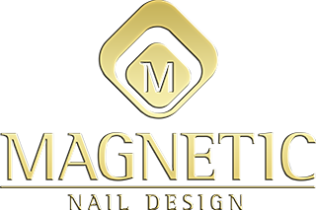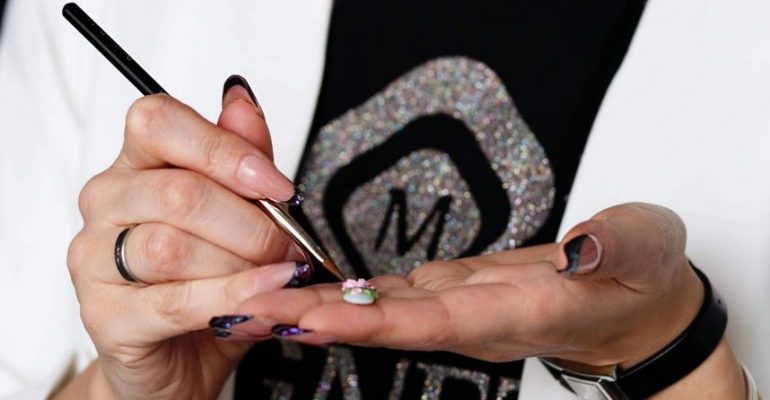Jungle of Brushes
August 27, 2020 2020-08-29 13:51Jungle of Brushes
Every nail technician knows that you need a good brush to apply gel or acrylic, for the smoothest result possible, in order to keep the filing and finishing of the artificial nail to a minimum.
The shape of a brush is flat, oval or round. The choice is very personal but most nail techs opt for an oval brush in Kolinsky hair for acrylics, because one can create sleeker smile line and can connect more accurately at the cuticle area. A flat brush has shorter hair and is suitable for the application of thin subsequent layers of gel. The first brushes that were used in the nail industry were round. Round brushes are still available but over time the oval brush became more popular.
The Hair
Magnetic acrylic brushes are made of real Kolinsky hair – hair from the tail of a weasel. Kolinsky hair has a fine point and is extremely elastic. Weasel hair is thin at the root, becomes thicker in the middle (“the belly”) and ends in an extremely sharp point. This special shape gives the hair the ability to carry heavy products like acrylics. There surface of Kolinsky hair has scales so that it can absorb enough liquid and can flow off the tip of the brush in a controlled way, which results in a constant mix ratio while the acrylic already air dries. This is important when working with liquid and powder.
Most Magnetic gel brushes are made of synthetic hair and are available in various shapes and diameters. For our brushes we use fibers with a diameter of 0.07mm, 0.14mm and 0.14mm. or a mic of these sizes depending on the gel thickness.
Most synthetic fibers thin out towards the end. They are tapered. There are various proportions to the degree of tapering, in other words; the point at which the fiber starts to thin out. The material of which this hair is made is called PBT (Polybutylene terephthalate). PBT has a smooth surface and does not absorb liquid, contrary to real hair. Liquid is therefore trapped in the spaces between the hairs. The thickness of a gel is established and should not be influenced. Working with real hair is therefore not recommended, because the real hair has the ability to absorb liquid and can alter the texture of the gel. The smooth surface of synthetic hair allows the gel to be applied easily and smooth, compared to natural hair, where the scales could actually have a negative impact on the result.
Your choice to work with a brush made of real hair or a brush made of synthetic hair therefore depends on the product that you are working with. For the best results use a brush made of real hair in combination with thin liquids like acrylic liquid, thin top gel, water color paint or acrylic paint. Brushes made of synthetic hair are used for thick and medium viscosity gels and for thicker materials like nail polish.
A brush is always made in the same way:
- Searching for and selecting the right hair and/or the right mix of hair.
- Determining the right quantity of hair to use, which is weighed per brush.
- Then the hair is positioned in a cup which is the same shape as the point of the brush, in other words, either round, oval or flat square. An acrylic, gel or nail art brush is formed in this way, in combination with the hair that was selected.
- Once the hair has been pressed into the cup, in order to achieve a sturdy shape, the hair is bound together with thread and glued into the ferrule (the material holder), and is then clamped in place. The other side of the ferrule is positioned over the steel handle and clamped in place.
- Every brush then gets the kiss of the brush maker and Arabic gum is applied to keep the last kiss in shape.
Each Magnetic brush is made by hand and should therefore be treated with respect.
How do you clean a brush before using it …
Remove the plastic protective band from a new brush. Do not put this back once the brush has been submersed in acrylic liquid. The liquid can cause the plastic to melt and adhere to the brush.
The hair of the new brush are held together with Arabic gum. This has to be removed thoroughly by rotating the hairs of the brush on a clean brush wipe until all of the gum has been removed. Be careful because if any Arabic gum is left behind, the brush will split.
Then submerse the brush in clean liquid. Rotate the brush so that all of the hair comes in contact with the liquid. You may not touch the hair of the brush once the brush has been submerged.
Ensure that all of the liquid comes out of the shaft of the brush: this will prevent discoloration. The rest of the liquid in the dappen dish is not suitable for further use; it may be contaminated with Arabic gum.
It is important to always wipe off the rest of the hairs of your brush in the same direction and also to store it in this shape if you want to get the best possible use out of your brush.
Proper cleaning and smart storage = important
- clean brushes after every use
- use liquid to clean an acrylic brush
- use only 70-80% alcohol or Prep & Wipe to clean a gel brush
- nail art brushes for acrylic paint should only be cleaned with water
- shape the hair back to the original shape after use
- keep your gel brush away from direct UV light from your lamp or from the sun
- store brushes in a horizontal position in a brush box, or better yet, use the click-on system
- Never store brushes in a vertical position on your desk. This way liquid or water will make its way into the metal band resulting in rust, which results in yellowing of the product.
A professional nail stylist will never put a brush upright ; in other words, with the hair facing up. If you do this the remaining liquid will make its way into the metal band (ferrule) that keeps the hair together. This will lead to rust contamination, which during the next use, will come out from the ferrule to the hair and will then cause product contamination and discolored / yellowed nails.
This does not merely apply to gel or acrylic brushes but also nail art brushes. Stored your cleaned brushes carefully at the end of the day and you won’t have problems with contamination. But how do you make sure that liquid or any other fluid does not make its way into your brush while you work? simple switch to the Click on System from Magnetic.


